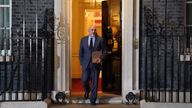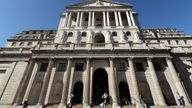Tax rises or spending cuts needed to avoid ‘unsustainable’ public debt, watchdog warns
Tax rises or spending cuts are needed to avoid an “unsustainable” public debt burden, the UK’s fiscal watchdog has warned.
The Office for Budget Responsibility (OBR) said the government faces a debt burden three times more than its current level due to increasing costs from an ageing population and falling future tax revenues from motor fuel.
Debt is on course to reach almost 320% of GDP in 50 years’ time – up from 96% currently – if successive governments do not tighten fiscal policy, the agency said.
It is forecast to rise to more than 100% of GDP in 30 years.
Bringing debt back to 75% of GDP – the level at which it stabilised in the government’s pre-pandemic budget – “would need taxes to rise, spending to fall, or a combination of both”, the OBR said.
This would require curbs of 1.5% of GDP – £37bn a year in today’s terms – at the beginning of each decade over the next 50 years, it added.
Public sector debt, excluding public sector banks, was £2.3trn at the end of March 2022 – or around 96.2% of GDP – an increase of £209.4bn or 2.3 percentage points of GDP compared with March 2021, according to the ONS. It has reached levels not seen since the early 1960s.
“The pressures of an ageing population on spending and the loss of existing motoring taxes in a decarbonising economy leaves public debt on an unsustainable path in the long term,” the OBR said.
Read more: Government hands over £7.6bn in record interest payment on public debt
The government is set to lose a huge source of tax revenue as it moves to ban the sale of new petrol and diesel-powered cars from 2030.
The UK’s ageing population brings with it added healthcare, pensions, and social care costs.
The OBR also said the government has so far spent as much this year to help households with the cost of living crisis – 1.25% of GDP – as it did to support the economy during the financial crisis.
Listen and subscribe to The Ian King Business Podcast here.
Public debt is now more than double the amount the OBR had expected it to be 20 years ago.
The OBR said risks to public finances include rising inflation, which could tip the economy into recession, “continued uncertainty about our future trading relationship with the EU” and a resurgence of COVID cases.
Other factors are rising interest rates and growing geopolitical tensions, which are exemplified by Russia’s war in Ukraine and have manifested in trade barriers between countries.
The government spent £7.6bn on interest payments to service its debt in May, far above the £5.1bn predicted by the OBR.


